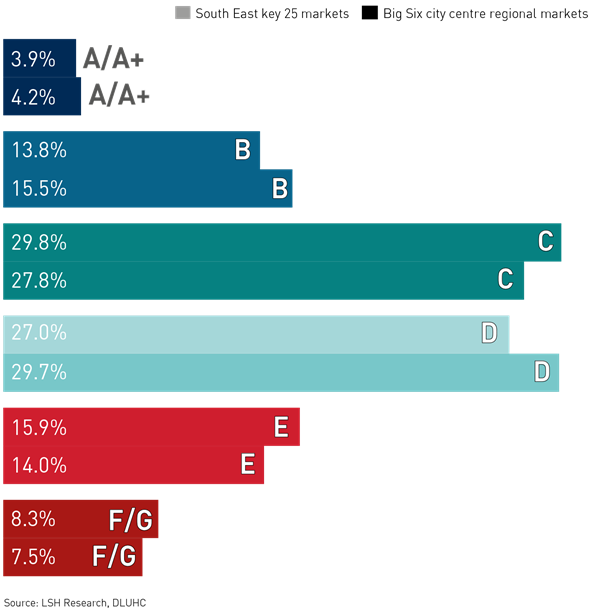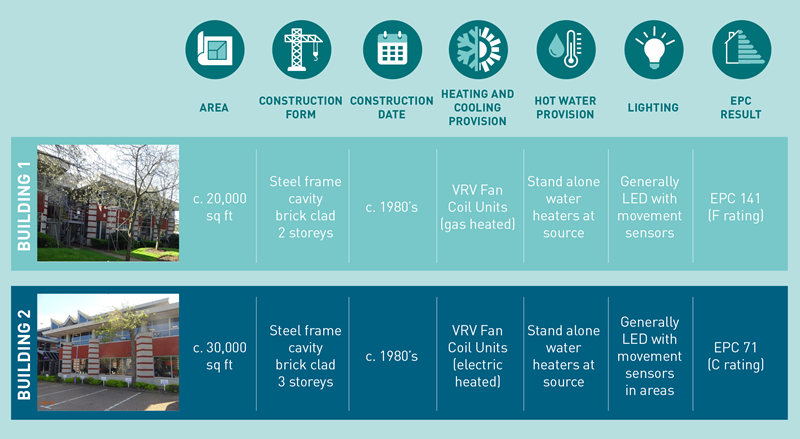Over the coming years, many landlords face an uphill struggle to ensure their office buildings comply with the Minimum Energy Efficiency Standards (MEES). But landlords need not despair. LSH’s EPC ratings assessor Anthony Kerr outlines how landlords can stay ahead of the game.
Download the Thames Valley and South East report in full here →
TIGHTENING STANDARDS
While the changes to MEES standards have been well-documented, the timeline for the tightening of regulations is set out below as a brief reminder. The most recent milestone came into being only recently. Since 1 April 2023, the standards were extended to prohibit landlords from leasing commercial buildings with an EPC rating of F or G.
The minimum standards are scheduled to tighten much further over the coming years. The next key milestone, scheduled for April 2027, will see the rules apply to any building with an EPC rating of below C, before rising once again to a minimum threshold of B ratings by April 2030.
Timeline of Key EPC Dates for Commercial Property

THE SCALE OF THE CHALLENGE
Assuming the MEES timeline is followed through, many landlords of regional offices have a relatively tight timeframe to ensure their assets remain compliant. LSH’s analysis of the government’s EPC Register gives a sense of the scale required to meet these tightening standards.
Firstly, a significant minority of office buildings are already now affected by the recent step up in the standards. For the 25 key markets of the South East region, LSH’s analysis reveals that approximately 8% of the existing floorspace is EPC rated F or G and is therefore now unlettable.
However, more striking is the amount of floorspace that will be affected over the coming years as the standards are tightened. As it currently stands, a further 43% of stock across the SE markets will become affected unless action is taken by April 2027, rising to a total figure of circa 80% by April 2030.
Approximate Breakdown of Office Space EPC Ratings by Floorspace (%)

CONSIDER THE RECOMMENDATIONS
Alarming as the above analysis may sound, landlords need not panic provided actions are planned ahead as swiftly as possible.
The starting point is to heed the recommendations within the EPC report. An EPC Plus report is worth having as it provides recommendations that can be planned and implemented over time. Crucially, this allows landlords to build up and/or deploy the capex over phases, rather than having to organise and pay for all the works at once. The EPC Plus report also takes into consideration the life cycle of the building’s equipment. Rather than hasten the obsolescence of equipment unnecessarily, a sequenced plan of action can be put in place which dovetails with the need for replacement.
PLANNING AND BUDGETING
Once the EPC recommendations are considered, the planning and budgeting phase of the works can be set out. There is however little time to waste here, as a valid EPC is required by 1 April 2025. With expert guidance, a review can assess what needs to be done and when for a whole portfolio of properties if required. Recommendations are costed, while future costs are indexed to account for inflation.
Crucially, an EPC Plus report will indicate the recommendations that fall outside the so-called ‘7 year rule’. If the payback period of a recommendation takes over seven years, it need not be carried out. If all recommendations within the seven-year payback have been implemented, no further works are required and in some cases these properties can be placed on the government’s exemption register.
USE THE EXPERTS
Landlords are strongly advised to instruct a reputable company for EPC commissioning and advice on remediation. This will provide the basis to carry out the work required at the optimum time, saving money and ensuring compliance with statutory requirements. Once this in place, the landlord can get on with the doing.
An inaccurate certificate risks a disastrous starting point for setting out improvements. It is also vital that default figures are not used in the calculations. The correct Coefficient of Performance, heating and cooling efficiency ratios or boiler efficiency can make quite a difference in EPC ratings and the recommendations that follow thereafter.
QUICK WINS
There are several quick wins than can help elevate a building’s EPC rating without requiring serious work to the property. Lighting is one area of low hanging fruit for offices as it carries a high weighting in the assessments. Simply changing old T8 or tungsten fittings for LED can in many cases go a long way towards achieving a higher EPC rating.
If the existing certificate is more than five years old, a landlord may well benefit from getting a new EPC for the building. The weighting and fuel factor for electricity has much improved since 2022, meaning a reassessment could potentially result in a better rating without doing anything to the building. However, if the building is gas-fuelled, the reassessed EPC rating could end up with a less favourable result.
EXAMPLES IN ACTION
LSH’s EPC team has a wealth of experience in both providing EPCs and implementing plans to improve ratings. The case studies outlined below illustrate LSH’s role in driving energy performance improvements.
The buildings, referred to as Building 1 and Building 2 for the purpose of this exercise, are located on an out of town office and industrial estate in Buckinghamshire and located next to each other. Initially, an EPC assessment was undertaken for each of the buildings, with the main characteristics of the buildings set out in the table below.

Despite the visual similarity between the two buildings, their EPC ratings are markedly different. Building 2 is MEES compliant up to 2027, while Building 1 is not even MEES compliant at the current time. The contrast is largely down to the different type of fuel used in the heating and cooling system.
However, according to the EPC recommendations for Building 1, there is a lifeline. The only recommendation that has a payback period within seven years is the application of a reflective coating or shading devices to the windows. This is relatively low cost compared with a wholesale replacement of the heating system, which happened to be in good working order and therefore not in need of replacement.
If the building was now to be let or sold following these relatively superficial works, the building can be placed on the MEES buildings exemptions register. However, this exemption only lasts for three years, after which a new listing will be required. As a result, the landlord will often feel prompted to make further improvements, or simply dispose of the asset to allow another investor to take charge.
WORKS DURING OCCUPANCY?
A key consideration for landlords is the extent of works that can be carried out with a tenant in situ. Some improvements, such as lighting replacement, are relatively superficial, while other works are much more disruptive and costly, such as heat exchanger replacement. The cost of decanting and relocating a tenant for a period of say four weeks might be deemed very disruptive.
The likelihood of these works being undertaken would be dictated by the current situation. If the tenancy has several years left to expiry, the more disruptive measures would likely not be considered, with only the improvement works that fall within the 7-year rule being undertaken.
In cases of more serious works, it naturally makes the most sense to apply these when the building becomes vacant. Indeed, if Building 1 was to be re-let, the works would become necessary on the basis that the building would be unlettable. Here we outline some of the actions a landlord might undertake to radically improve an office’s EPC rating.
FABRIC FIRST APPROACH
The best approach is to work on a ‘fabric first’ basis, before then going on to improve the efficiency of the heating and hot water provision. Only after these measures are applied is it worth considering the addition of the renewable technologies such as PV. Using our case study buildings, the recommendations for improvements and the estimated costs, as well as the EPC improvement post works are as follows:

As the graphic indicates, implementation of the recommendations that fall within the 7-year payback rule do not help to improve the EPC level but will allow Building 1 to be entered onto the exemptions register. Meanwhile, Building 2 remains compliant.
Subsequent implementation of the fabric first measures, roof and external wall insulation, would see a jump into the higher EPC category for both buildings, with Building 2 achieving an EPC B rating and compliant under the current rules in 2030.
Building 1, following costly moves to replace the heat exchanger plant and utilising electricity instead of gas sees the EPC move to a C rating and would therefore be compliant under the current rules in 2027, but not 2030. Further application of photovoltaics onto the roof then sees the building jump to a B rating and compliance with 2030 requirements.
The path that leads to a B rating may be daunting but, armed with a proper plan, the destination is not insurmountable.
The above examples are of course indicative. Every building is different and should be taken on their own merits. If you require expert advice relating to MEES, LSH’s dedicated EPC Assessor team would be happy to assist.
Download the Thames Valley and South East report in full here →
Get in touch

Email me direct
To:
REGISTER FOR UPDATES
Get the latest insight, event invites and commercial properties by email







